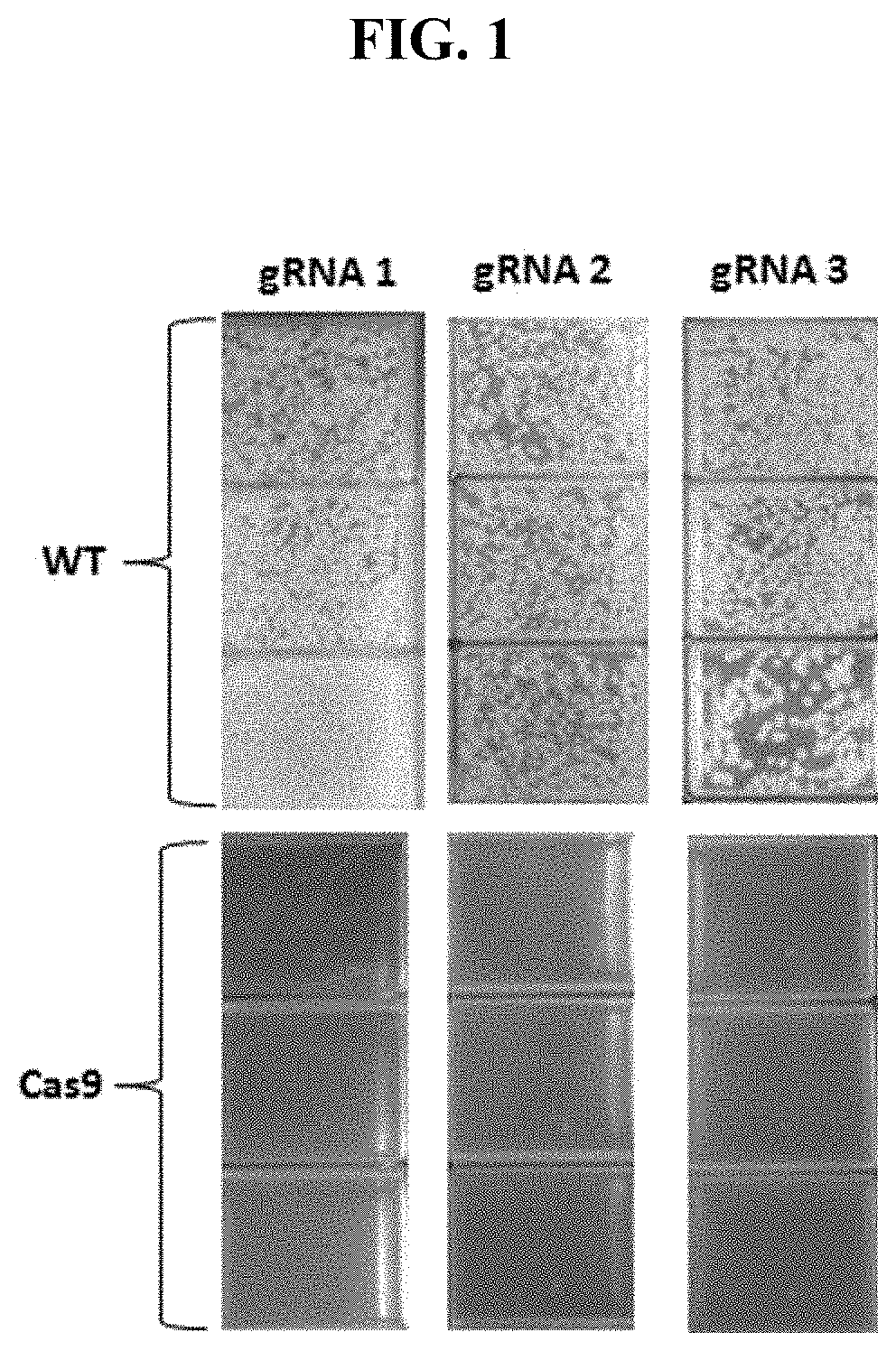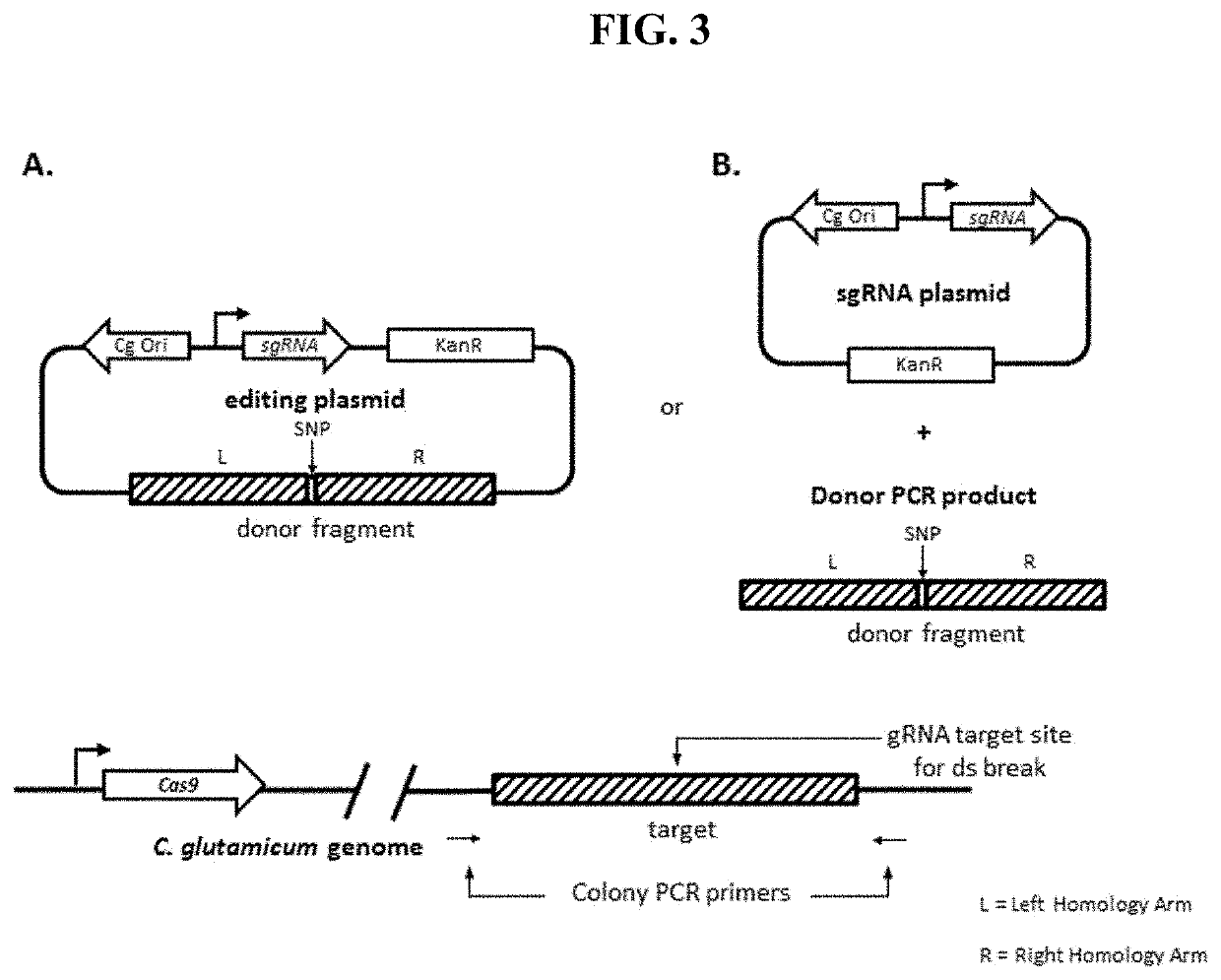Genome editing using crispr in corynebacterium
- Summary
- Abstract
- Description
- Claims
- Application Information
AI Technical Summary
Benefits of technology
Problems solved by technology
Method used
Image
Examples
example 1
Cas9 can Induce Lethal DSBs in C. Glutamicum when Expressed in Conjunction with Functional Guide RNA
[0146]The Cas9 gene from Streptococcus pyogenes with a codon bias for Streptomyces (Cobb et al. ACS Synth. Biol. 4, 723-728 (2015)) was synthesized and linked to the Ptrc promoter and integrated into NRRL-B11474 Corynebacterium glutamicum for expression of Cas9.
[0147]Cas9 activity was tested in a strain where Cas9 was integrated in the cg0443-cg0444 locus. As double stranded breaks (DSBs) are lethal when repair is ineffective, no colonies were expected to form beyond a few escape mutants (FIG. 1). Upon transformation of plasmids with Pcg2613 as the promoter driving guide RNA expression, as shown in FIG. 1, the lethal effect of the resulting Cas9 DSB was demonstrated and thus Cas9 was functional in NRRL-B11474 C. glutamicum. FIG. 2 demonstrates that the lethal effect of a functioning sgRNA can be generalized across a variety of loci of interest.
example 2
CRISPR / Cas9 Genome Editing—SNP Introduction
[0148]After successfully demonstrating the functionality of Cas9 and the guide RNAs to be used, plasmids were designed to introduce SNPs at 3 test loci using the validated guide RNAs and a corresponding donor polynucleotide encoded together on a single plasmid. A schematic of the configuration used to introduce SNPs is shown in Panel A of FIG. 3. Targeted SNPs were single mutations in each locus that alter the PAM region. Target SNPs at the PAM region prevent subsequent cutting of the modified genome by the CRISPR / Cas9 complex. The results were compared to a strain containing Cas9 and expressing only guide RNA, and NRRL-B11474 C. glutamicum without Cas9 integrated but with plasmids containing identical guide RNA and donor fragments used in Cas9 integrated strains.
[0149]Colonies from a transformation with the guide RNA / donor DNA plasmid were tested via colony PCR and NGS sequence analysis. An example of one NGS coverage plot is depicted in F...
example 3
CRISPR / Cas9 Genome Editing—Gene Deletion
[0150]Deletion of 702 bp from the cg3031 locus was tested. An overview of the strategy to knock out the cg3031 ORF in C. glutamicum is provided in Panel A of FIG. 4. As in the above examples Cas9 was integrated into the genome; donor polynucleotides containing 340 bp left arm homology and 400 bp right arm homology to the cg3031 ORF and a guide RNA cassette were introduced on a single plasmid. Removal of the 702 bp region of cg3031 was detectable by PCR, as shown in FIG. 13. A 1648 bp band is indicative of a wild-type genome; while a 946 bp band is indicative of a modified genome. Analysis of colonies produced after transformation demonstrated the presence of the deletion of 702 bp from the cg3031 locus in 6 out of 8 colonies.
PUM
 Login to View More
Login to View More Abstract
Description
Claims
Application Information
 Login to View More
Login to View More - R&D
- Intellectual Property
- Life Sciences
- Materials
- Tech Scout
- Unparalleled Data Quality
- Higher Quality Content
- 60% Fewer Hallucinations
Browse by: Latest US Patents, China's latest patents, Technical Efficacy Thesaurus, Application Domain, Technology Topic, Popular Technical Reports.
© 2025 PatSnap. All rights reserved.Legal|Privacy policy|Modern Slavery Act Transparency Statement|Sitemap|About US| Contact US: help@patsnap.com



